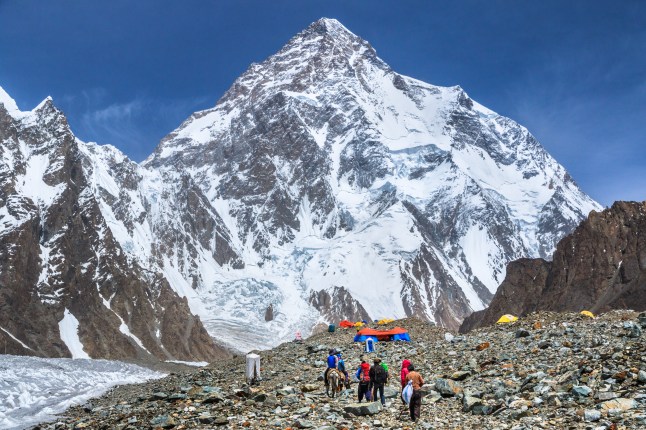
Pakistan’s newest and most expensive airport has no passengers and no planes, and no one seems to know when New Gwadar International Airport will open for business.
Located in the coastal city of Gwadar, on the shores of the Arabian Sea, the airport has been entirely financed by China to an estimated cost of £190 million.
Over the past decade, China has poured billions into Pakistan’s Balochistan region, connecting its western Xinjiang province with the Arabian Sea, a route known as the China-Pakistan Economic Corridor (or CPEC).
While authorities have hailed it as transformational, there is little evidence of change in Gwadar.
The city isn’t connected to the national grid (electricity comes from neighbouring Iran or solar panels), and there isn’t enough clean water.
In a place such as this, it’s hard to imagine an airport with a 400,000 passenger capacity being a priority for the city’s 90,000 people.
The government says the economic corridor has created some 2,000 local jobs but it’s not clear whom they mean by ‘local’ — Baloch residents or Pakistanis from elsewhere in the country.
Azeem Khalid, an international relations expert who specialises in Pakistan-China ties, said it’s clear who really benefits.
‘This airport is not for Pakistan or Gwadar,’ he told AP. ‘It is for China, so they can have secure access for their citizens to Gwadar and Balochistan.’

Pakistan, keen to protect China’s investments, has stepped up its military footprint in Gwadar to combat dissent. The city is a jumble of checkpoints, barbed wire, troops, barricades, and watchtowers.
Roads close at any given time, several days a week, to permit the safe passage of Chinese workers and Pakistani VIPs.
Pakistan: an emerging travel destination
The UK Foreign Office advises against travel to Balochistan, partly due to the risk of militant activity. But there are plenty of areas in Pakistan that are safe to travel to — and tourists are catching on.
Back in the 1970s, Pakistan was a hotspot for adventure travel. It was a popular spot on the ‘hippie trail’ from Europe to south Asia, a form of alternative tourism that focused on travelling cheaply.
Decades of political instability put an end to that, but Pakistan is slowly regaining its reputation.
In 2023, the south Asian country saw international tourist numbers increase by 115% compared to previous post-Covid years.

Earlier this year, Pakistan’s national flag carrier, Pakistan International Airlines (PIA), resumed flights to Europe on January 10, ending a four-year ban by the European Union’s aviation agency over safety standards.
The EU blocked PIA in 2020 after one of its Airbus A-320s crashed in the southern Pakistani city of Karachi, killing 97 people.
Now, the airline has relaunched flights to Paris, and is looking at running direct flights to Oslo and Copenhagen, with potential plans to launch Barcelona as an independent destination soon.
PIA also has ambitions to restart flights to London, Manchester and Birmingham.
Meanwhile, Pakistan recently introduced visa fee waivers for 126 nationalities. Since August 2024, visitors from countries including the UK, US, Australia and all EU member states have been issued free online visas within 24 hours of application.
Previously, they cost the equivalent of $60 and could take weeks to process. But despite these recent changes, travel experts tell Metro they aren’t worried about an influx of Western tourists.
Nick Pulley, founder of travel tour company Selective Asia, doesn’t foresee a huge increase in visitors any time soon.
‘The troubles Pakistan had with terrorism 10 to 15 years ago are a thing of the past, now it’s considered by everyone to be much safer. But it takes a very long time for the trust to return and for the stigma to wear off,’ he says.
Nick adds: ‘Pakistan is not without its challenges. There are parts that are safe to visit, and parts that are unsafe, but you can have a phenomenal experience while staying in the safe places. It’s about taking care, planning your travel and travelling with informed tour operators.’
Metro recently named Pakistan as an unmissable destination to visit in 2025 thanks to its vast valleys and mountain ranges in the north, and we’re not the only ones noticing all the country has to offer.

Annabel Grossman, global travel editor for The Independent, and Maureen O’Hare, senior travel producer at CNN, both named Gilgit-Baltistan in Pakistan as a top place to visit in 2025.
The mountainous region is fast becoming a destination dupe for the more overcrowded Himalayas, where the allure of Everest has seen the region overrun with commercial tourism, placing a huge strain on the natural environment.
Last year, the Nepalese army said it had removed 11 tonnes of rubbish left by climbers on the mountain. Nepal also banned solo hiking in April 2023, meaning visitors must use a licensed guide. Going it alone is not an option.
In contrast, Gilgit-Baltistan offers unspoiled peaks ripe for exploration.
The region is home to five of the 14 ‘eight-thousander’ mountains (those that are more than 8,000 metres above sea level), including K2, the world’s second-tallest.
But it’s more than just a substitute for the thrill of Everest.
James Wilcox, founder of adventure travel company Untamed Borders, says: ‘The novelist James Hilton wrote a book in the 1930s called Lost Horizon, describing a place called Shangri-La. We think of it as Tibetan, but actually the Humza Valley in Gilgit-Baltistan was the inspiration for it.’
Boasting lush green meadows, snow-capped peaks and crystal clear winding rivers, it’s hardly a surprise the region inspired the fictional utopia and, as James tells Metro, ‘it doesn’t have to be an alternative to the Himalayas — it’s even more mindblowing.’
During peak climbing season, which falls in June, July and August, the area becomes very busy.
Nick says: ‘Climbers are always going to go there for the peak climbing months because that’s the only time that you can climb these big peaks. But there’s plenty of infrastructure there because it has to deal with big traffic in key months.
‘Trekkers have a much broader window, so looking to trek outside of peak months is a way to reduce the impact on these areas.’

He adds that heading off the beaten track can help spread the burden of tourism.
‘When we think of the mountains in Pakistan, we think of Humza, Gilgit and Skardu. But there are a lot of other valleys a relatively short distance away — places like the Ghizer Valley, Punyal, Yaswn — that are lesser visited and very scenic, great for trekking and for day hikes as well,’ he explains.
‘I think as interest increases, it’s really important to look beyond the obvious big three. The wider we spread the tourism footfall, the greater the benefit to the communities.’
Elsewhere, Pakistan is home to a range of diverse ecosystems and breathtaking scenery, from the mud volcanoes of Hingol National Park to the lush Indus Valley and an array of UNESCO heritage sites that include some of the world’s earliest civilisations.
Its towns and cities are filled with bustling bazaars, ancient mosques and vibrant festivals, while rural areas are home to some of the world’s most remote and rarely visited nomadic communities.
Nick notes: ‘A lot of local operators are starting to recognise that demand is increasing, and I think 2026 and into 2027 will be where we start to see an increase in travel to Pakistan.
‘The economic situation of the country is still very poor, but as the economy improves and the stability of the government improves, tourism will improve too.’

Where is safe to travel to in Pakistan?
Despite the political instability Pakistan has experienced, the South Asian country offers many areas that are safe and open to international tourists.
Travel tour companies including Intrepid and G Adventures run tours to Lahore, Islamabad, the Hunza Valley and the Karakoram Mountains — always follow Foreign Office advice on the regions to avoid.
Areas where the Foreign Office advises against travel:
- Within 10 miles of the border between Pakistan and Afghanistan
- Khyber Pakhtunkhwa Province
- All travel to Balochistan Province, except the southern coast of Balochistan
- Pakistan-administered Kashmir
- Sindh Province
Pete Royall, Pakistan expert at adventure travel company KE Adventure, tells Metro that the country is a hospitable, friendly place.
‘Almost everywhere you go you get a warm welcome,’ he says. ‘There are regions best not to visit but they are few and far between, and areas like this exist in most countries.
‘Of course it’s important to be observant and respectful of local customs. For example, when visiting towns and villages women should wear a headscarf and a long skirt or trousers.’
He adds: ‘For people interested in mountains and trekking, Pakistan is one of the most spectacular places on the planet.’
It’s worth bearing in mind that those planning on climbing or trekking in Pakistan require a mountaineering and trekking visa, rather than a tourist visa.
According to the Pakistani government website, these visas are valid for up to three months and usually take four weeks to process.
How to get to Pakistan
Emirates, Etihad and Qatar Airways all fly from London Heathrow to both Islamabad and Lahore with one stop.
British Airways fly non-stop from London Heathrow to Islamabad from £623 return. The journey takes around eight hours.
MORE: Warning to holidaymakers as all flights cancelled at major European airport for 24 hours
MORE: Couple forced to sit next to dead body on a plane after woman dies during flight
MORE: Packing a suitcase standing up — the bizarre way to fit more in your luggage














